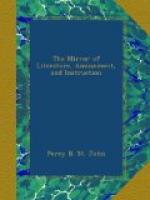paternal relation with domestic and fire-side animals,
especially with cats. While he sat painting,
a cat might generally be seen sitting on his back
or on his shoulder; and many times he kept, for hours,
the most awkward postures, that he might not disturb
it. Frequently there was a second cat sitting
by him on the table, watching how the work went on;
sometimes a kitten or two lay in his lap under the
table. Frogs (in bottle) floated beside his easel;
and with all these creatures he kept up a most playful,
loving style of conversation; though, often enough,
any human beings about him, or such even as came to
see him, were growled or grunted at in no social fashion.
His countenance, especially in latter years, was a
mixture of the bear’s, the lion’s, and
the human, for most part of a dull brick-colour; so
that many people, particularly children, were afraid
to look at him. In figure he was very small, and
bent; but, at the same time, had hands and fingers
of extraordinary size and coarseness, with which,
nevertheless, he produced the cleanest and prettiest
drawings. His chief diligence and most careful
elegance he brought to work in the painting of his
beloved cats. In right delineation of their forms
he had the art to seize the general nature of this
animal, and, in the portrait-like indication of their
various physiognomies, to reflect the specific character
of each. The sycophantic look full of falseness,
the dainty movements of the kittens, several of which
are sometimes painted sporting round their dam—all
this, in the most multifarious postures, turns, groups,
sports, and quarrels, is depicted with a true observance
to nature,—nay, one might say with genius
and fidelity.
On Sundays and winter nights, Mind, by way of pastime,
used, out of dried, wild chestnuts, to carve little
cats, bears, and other beasts, and this with so much
art that these little dainty toys were shortly in
no less request than his drawings. It is a pity
that insects, such as frequently exist in the interior
of chestnuts, have already destroyed so many of these
carvings.
At the Barengraben (bear-yard) in Bern, where
a few live bears are always to be seen, Mind passed
many a happy hour; and, between the beasts and him
there seemed to prevail a singularly confidential
feeling. The moment Friedli—such was
the name Mind was best known by in Bern—made
his appearance, the bears hastened towards him with
friendly grumbling, stationed themselves on their
hind feet, and received, impartially, each a piece
of bread or an apple out of his pocket. For this
reason, bears, next to cats, were a favourite subject
of his art; and he reckoned himself, not unjustly,
better able to delineate these animals than even celebrated
painters have been. Moreover, next to his intercourse
with living cats and bears, Mind’s greatest joy
was in looking at objects of art, especially copper-plates,
in which, too, animal figures gave him most satisfaction.




